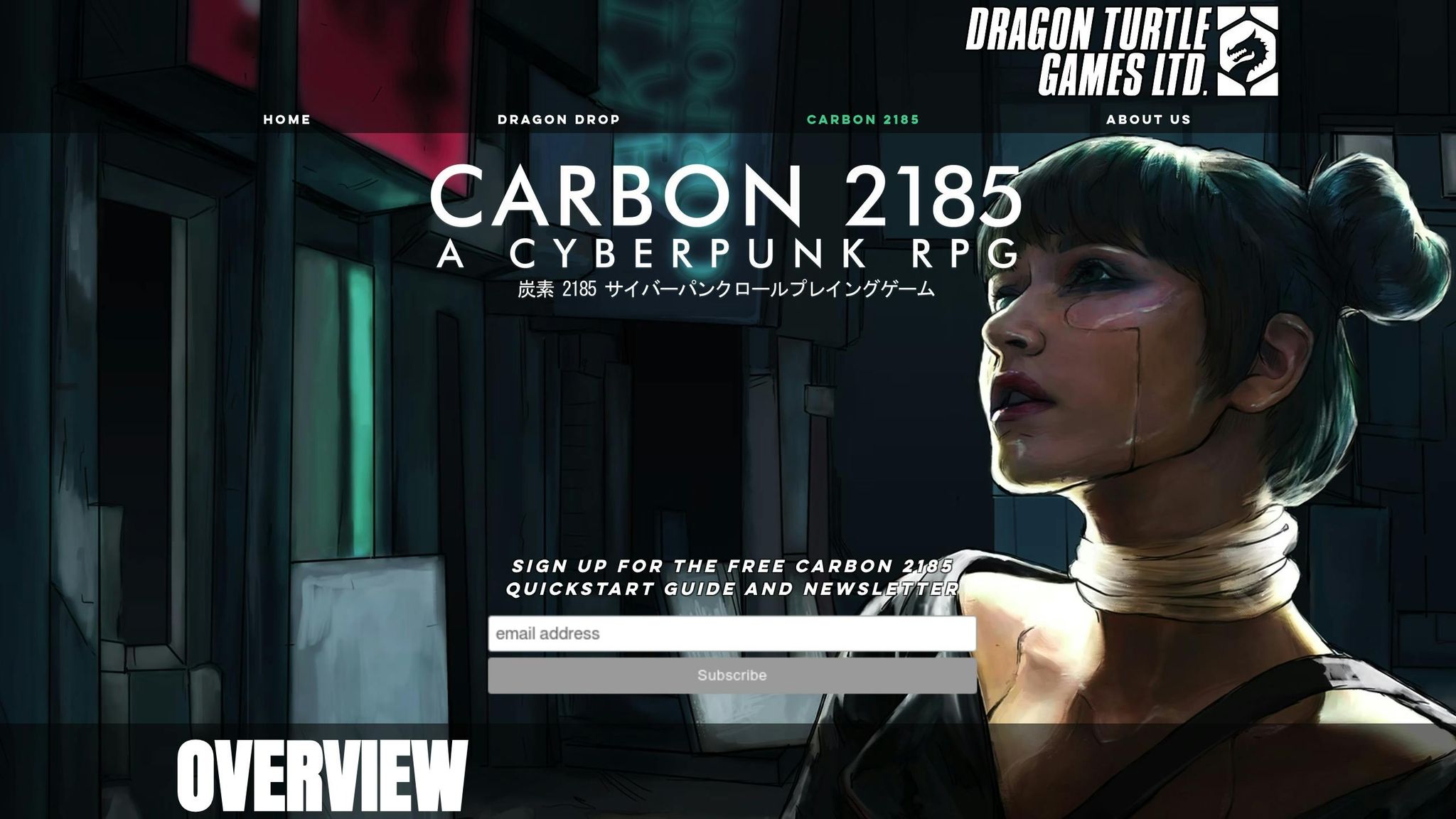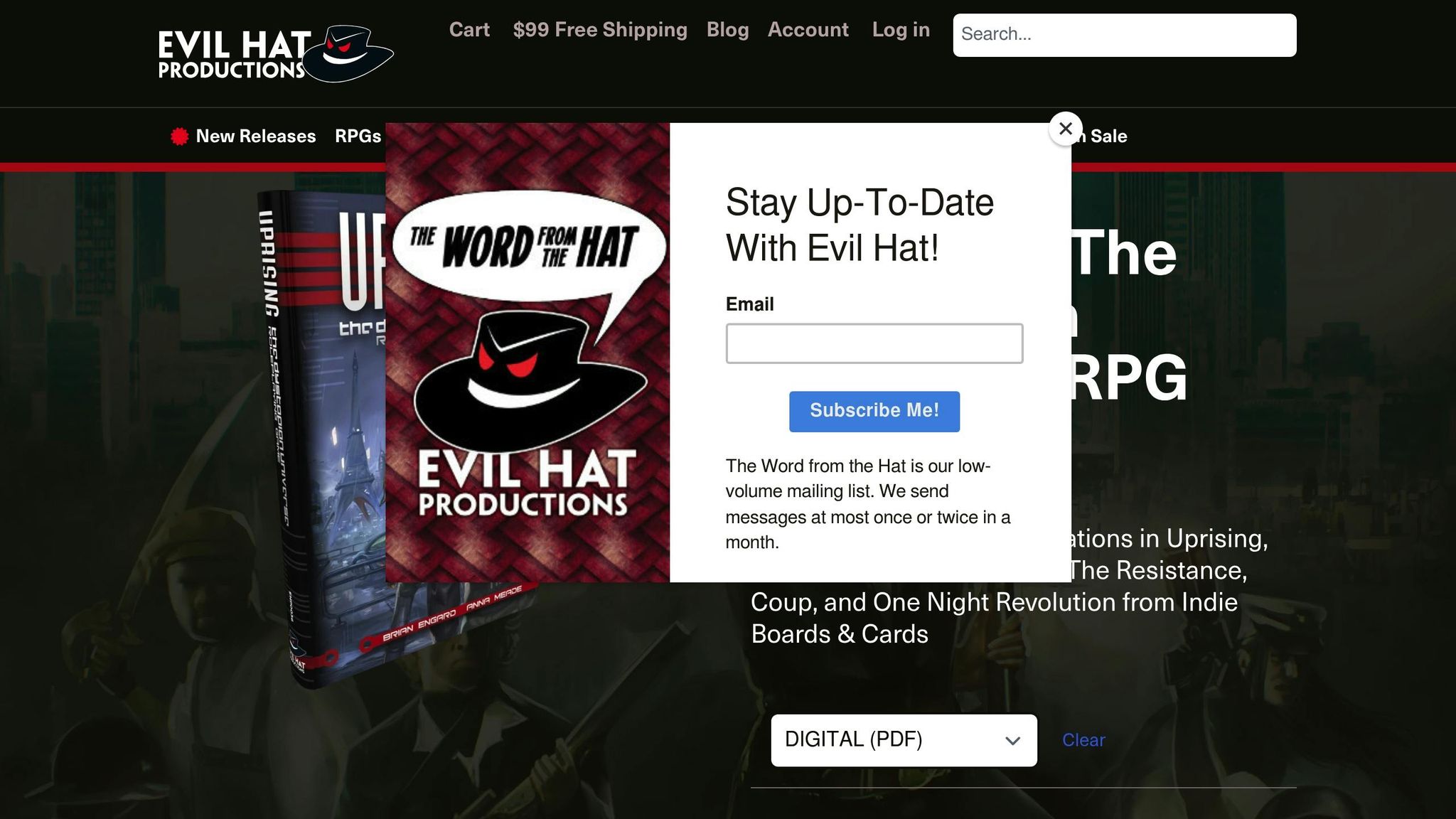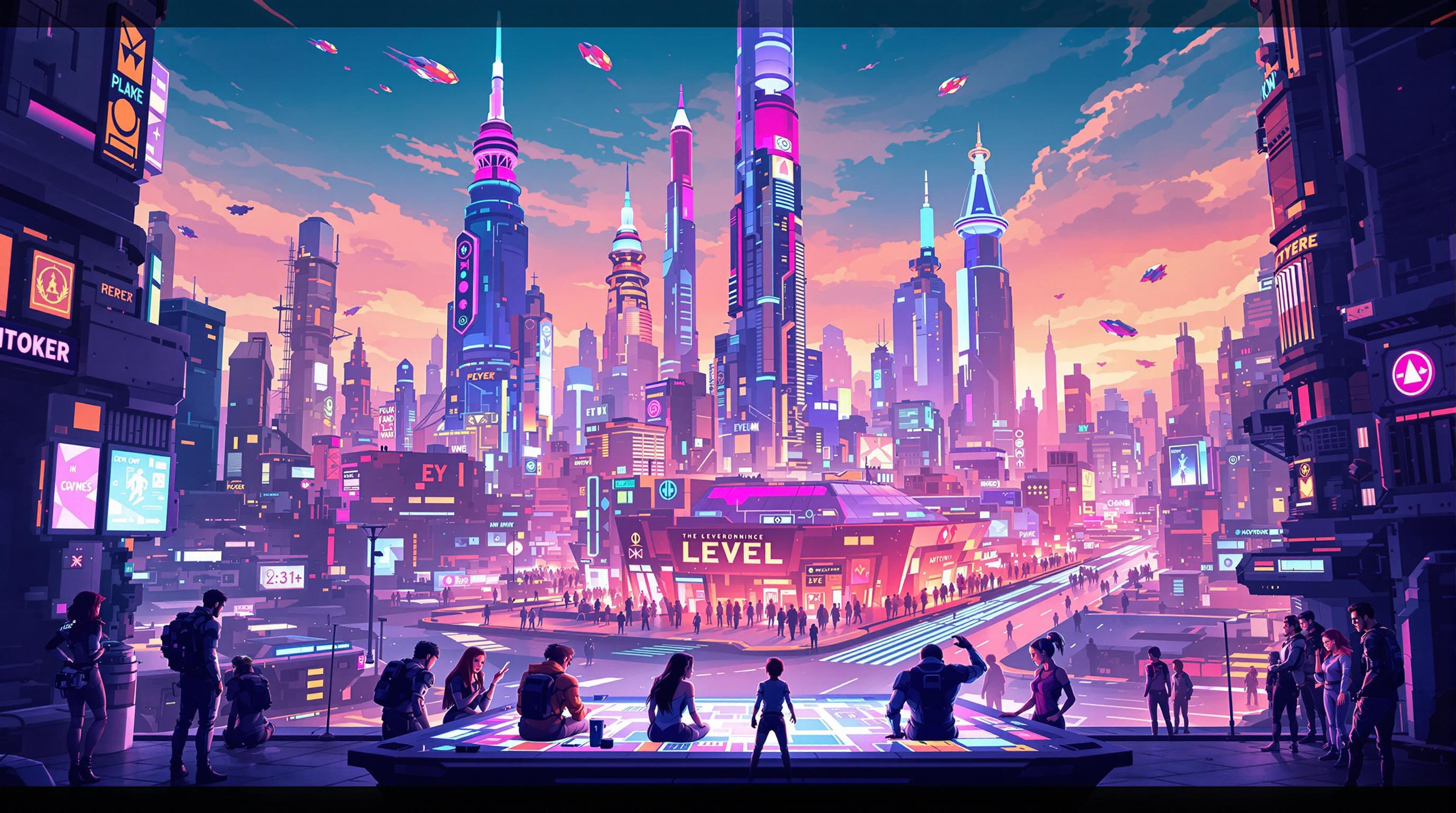Looking for the perfect cyberpunk RPG? Here's the quick breakdown:
Carbon 2185 is all about tactical combat, detailed character customization, and cybernetic upgrades. If you love strategy and tech-heavy gameplay, this one's for you.
Uprising, on the other hand, focuses on storytelling, social dynamics, and collective resistance. It's ideal for players who enjoy narrative-driven, group-focused campaigns.
Quick Comparison
| Feature | Carbon 2185 | Uprising |
|---|---|---|
| Core System | Attribute-based | Narrative-driven |
| Focus | Tactical combat, tech upgrades | Storytelling, social resistance |
| Customization | Cybernetic enhancements | Character motivations and relationships |
| Gameplay Style | Individual progression | Group dynamics |
| Best For | Strategy lovers, experienced players | Story-focused, new players |
Choose Carbon 2185 for detailed systems and personal growth. Opt for Uprising if you prefer collaborative storytelling and themes of rebellion.
Game Rules and Systems
Making Characters
In Carbon 2185, creating a character involves assigning points to core attributes and selecting from preset character classes. Players can also integrate cybernetic upgrades to enhance technical skills, adding another layer of customization.
Uprising, on the other hand, takes a more narrative-driven approach. Instead of focusing on numerical stats, players shape their characters around identity, motivations, and key relationships. Roles in this system highlight the character's place in the rebellion, prioritizing personal beliefs and social connections over traditional stats.
| Feature | Carbon 2185 | Uprising |
|---|---|---|
| Core System | Attribute-based framework | Narrative-driven design |
| Character Roles | Predefined classes with tech options | Story-driven rebellion roles |
| Customization | Cybernetic upgrades available | Story-focused character advantages |
| Gameplay Emphasis | Tactical and tech-heavy | Social and narrative-driven interactions |
These contrasting approaches create distinctly different gameplay experiences.
Basic Game Mechanics
Carbon 2185 relies on a dice-based system to resolve actions. Players use modifiers tied to their characters' abilities to determine success in combat or skill challenges.
In Uprising, a dice pool mechanic comes into play. The number of dice rolled reflects a character's abilities, and players can take calculated risks to influence the story's direction.
Both systems are further enriched by their unique gameplay elements.
Special Rules
Carbon 2185 introduces specialized mechanics for digital encounters and cybernetic upgrades. Players must carefully weigh the advantages of these enhancements against potential side effects.
Uprising focuses on collaboration and narrative-driven decisions. Players can shape the story while facing risks tied to corporate retaliation.
These rules reflect the games' differing cyberpunk styles. Carbon 2185 caters to those who enjoy tactical gameplay and technological strategies, while Uprising appeals to players who prefer narrative depth, social interaction, and exploring ideological conflicts.
World and Theme
These immersive worlds not only provide the backdrop for action but also highlight the contrasting gameplay styles discussed earlier.
Carbon 2185's World

Carbon 2185 presents a tech-heavy dystopia dominated by megacorporations. The setting features advanced technology like neural implants, omnipresent augmented reality, and autonomous systems. Towering arcologies and holographic ads loom over urban slums, creating a stark contrast between wealth and poverty.
Key locations include:
- Corporate zones: Sleek architecture with tight security
- Underground tech markets: Hubs for illegal cybernetics
- Abandoned industrial areas: Now occupied by various factions
- Data havens: Where hackers trade sensitive information
On the other hand, Uprising builds its world around political tensions and social inequality.
Uprising's Setting

Uprising takes place in a politically charged environment where corporate influence shapes society. The game focuses on grassroots resistance movements and community-driven efforts within corporate-controlled regions.
The world is divided into distinct social layers:
| Layer | Description | Features |
|---|---|---|
| Corporate Elite | Executives and top managers | Luxurious enclaves, private security |
| Middle Management | Corporate employees and experts | Regulated housing, constant oversight |
| The Resistance | Activists and rebels | Hidden bases, covert networks |
| The Displaced | Those outside corporate systems | Makeshift settlements, black markets |
These contrasting settings highlight the thematic differences between the two games.
Theme Comparison
The world designs enhance the gameplay contrasts. Both games explore corporate dystopias but take different approaches.
- Carbon 2185: Focuses on individual survival and technological upgrades. The narrative revolves around personal augmentation and skill-based missions.
- Uprising: Centers on collective resistance and social dynamics. It delves into how communities challenge corporate dominance.
Key differences include:
- Individual vs. Collective: Carbon 2185 emphasizes personal growth, while Uprising explores group efforts.
- Technology’s Role: In Carbon 2185, tech upgrades enhance individual abilities. In Uprising, technology serves as a tool for social change.
- Storytelling: Carbon 2185 uses mission-driven narratives, whereas Uprising unfolds through community and political struggles.
sbb-itb-b8b00a5
Story and Gameplay
GM Tools
Both games enhance their immersive experiences by offering detailed tools for Game Masters (GMs). These resources are designed to help GMs craft rich narratives and manage gameplay effectively.
Here’s a breakdown of the GM tools available in each system:
| Feature | Carbon 2185 | Uprising |
|---|---|---|
| Campaign Tools | Mission generators, NPC databases | Community relationship maps, faction trackers |
| Adventure Support | Corporate security layouts, tech item tables | Resistance cell templates, social movement guides |
| World Building | District generation, corporate profiles | Community creation tools, power structure frameworks |
Player Choices
Carbon 2185 emphasizes individual progression, allowing players to enhance their characters with cybernetic upgrades and tactical gear. On the other hand, Uprising prioritizes group dynamics, where player decisions influence community relationships, resource management, and the broader rebellion effort.
These contrasting systems create very different campaign experiences, catering to both personal and collective playstyles.
Campaign Options
Both games reflect their dystopian themes through unique campaign structures, each offering varied missions and objectives.
-
Carbon 2185 campaigns focus on corporate-driven narratives, including:
- Corporate Infiltration: Espionage and data theft
- Street Level: Urban survival scenarios
- Tech Hunter: Searching for rare technologies
- Mercenary Operations: Military-style missions
-
Uprising campaigns lean into resistance and social change, featuring:
- Resistance Building: Organizing anti-corporate movements
- Underground Networks: Covert operations and support
- Social Revolution: Driving systemic change
- Corporate Defection: Recruiting assets from within corporations
These options allow players to dive into worlds of espionage, rebellion, and survival, each with its own flavor and challenges.
Corporate Elements
Corporate Power
In Carbon 2185, corporations are depicted as massive, tech-focused entities that dominate everyday life. In contrast, Uprising portrays them as oppressive forces that subtly manipulate society. While Carbon 2185 emphasizes the overwhelming presence of corporate influence, Uprising highlights grassroots resistance against this control, creating distinct narratives around corporate dominance.
Tech Impact
Technology plays a central role in both games but in contrasting ways. In Carbon 2185, advanced tech like cybernetic upgrades and digital systems is deeply integrated into character development and storytelling. Meanwhile, Uprising frames technology as a tool of corporate dominance that players must disrupt to achieve their goals. These differing approaches also reflect how each game envisions technology’s role in shaping social hierarchies.
Social Systems
The portrayal of society under corporate rule varies significantly between the two games. Carbon 2185 illustrates a divided society where access to technology and corporate connections reinforce rigid social hierarchies, a hallmark of cyberpunk themes. On the other hand, Uprising focuses on collective action and community-driven resistance, encouraging players to build alliances to challenge and dismantle corporate power structures.
Final Comparison
This section breaks down the key differences between the two games, helping you pick the best fit for your next campaign.
Carbon 2185 Pros and Cons
| Pros | Cons |
|---|---|
| Extensive cybernetic customization options | Complex rules may slow down gameplay |
| Richly detailed corporate-driven world | Steep learning curve for newcomers |
| Strong tactical combat system | Limited focus on group storytelling |
| Wide range of tech upgrades | Character creation can take a while |
Uprising Pros and Cons
| Pros | Cons |
|---|---|
| Simplified mechanics for resistance gameplay | Fewer character customization options |
| Emphasis on community-driven play | Less detailed tech advancement |
| Easy-to-learn rules | Fewer campaign options in scope |
| Built-in group-focused dynamics | Less emphasis on tactical combat |
Player Guide
The comparison above highlights each game's strengths. Here's how to decide based on your group's playstyle and preferences.
Pick Carbon 2185 if you enjoy:
- Intricate character customization, including cybernetics
- Tactical combat with strategic depth
- Individual-focused character growth
- Classic cyberpunk themes and storytelling
Opt for Uprising if you prefer:
- Collaborative storytelling and shared narratives
- Themes of social resistance and community action
- Fast and easy setup with straightforward rules
- Campaigns centered around teamwork and group dynamics
Match the game to your group's experience level and playstyle:
- Carbon 2185 suits those who love detailed systems and personal progression.
- Uprising is perfect for players who enjoy narrative-driven, collective gameplay.
- If you're new to tabletop RPGs, start with Uprising for its simpler mechanics.
- Experienced players will appreciate the depth offered by Carbon 2185.
Whether you're drawn to personal survival or collective resistance, these games provide distinct experiences tailored to your group's needs.


